Abstract
OBJECTIVE: To compare the use of low dose intramuscular ketamine with high dose intranasal midazolam in children before suturing. METHODS: Altogether 102 children with simple wounds between 1 and 7 years old were allocated to the two study groups. RESULTS: Two children were excluded from the study because of deviation from the agreed protocol. The 50 children in the ketamine group were less likely to cry or need to be restrained during the procedure than those in the midazolam group (p < 0.01). The median oxygen saturation was 97% in both groups. There was no difference in the recovery behaviour and the range of time at which children were ready for discharge, although the median time for the latter was shorter in the midazolam group (75 v 82 minutes). Vomiting occurred in nine of the ketamine and four of the midazolam group. After discharge both groups had an unsteady gait (73% v 71%) which usually resolved within two hours. CONCLUSION: Intranasal midazolam (0.5 mg/kg) effectively sedated the children in that none could remember the suturing. However a significant number still had to be restrained (86% v 14%). Intramuscular ketamine (2.5 mg/kg) produced dissociative anaesthesia in the majority of cases and was the preferred drug of nurse, doctor, and parent.
Full text
PDF
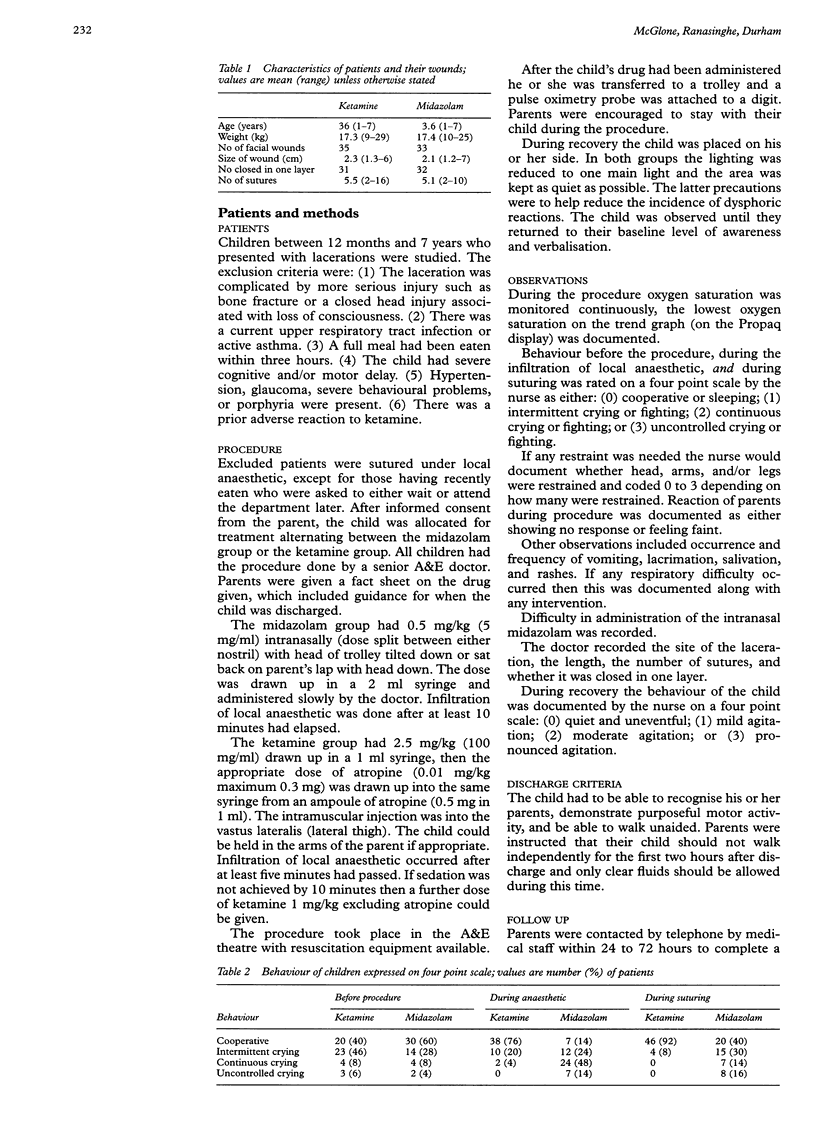
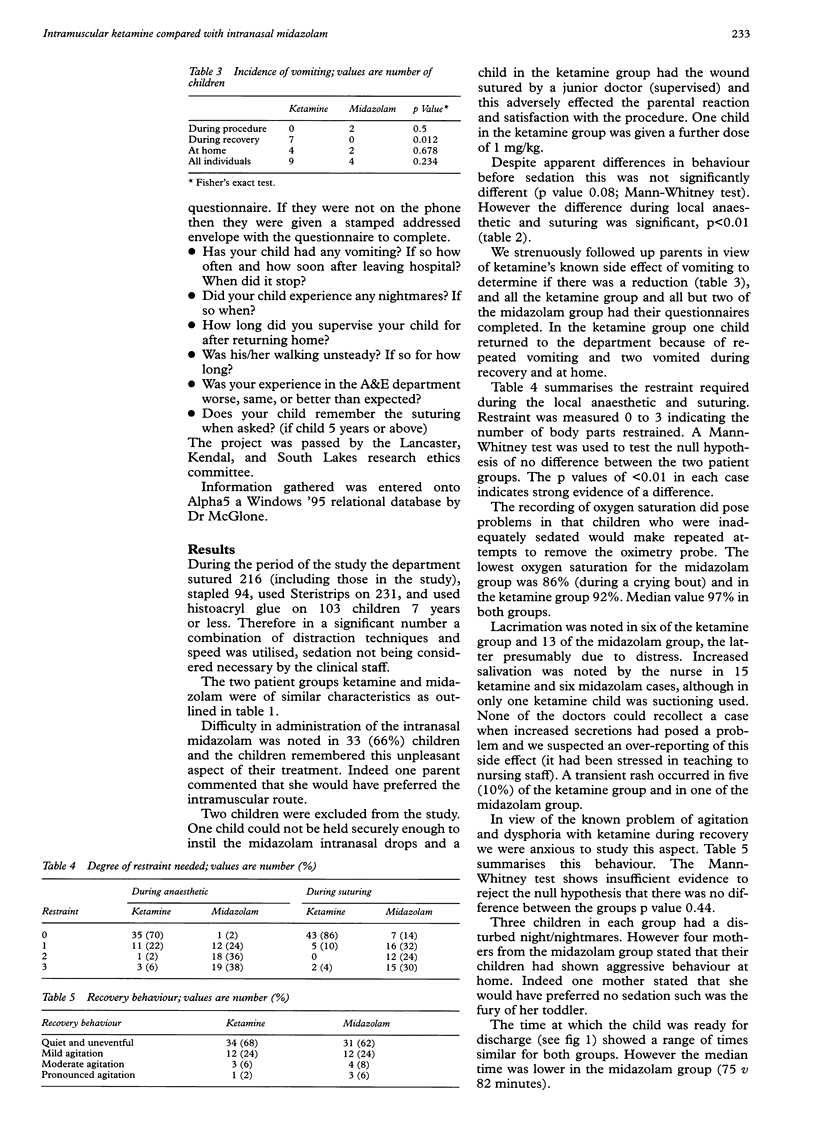
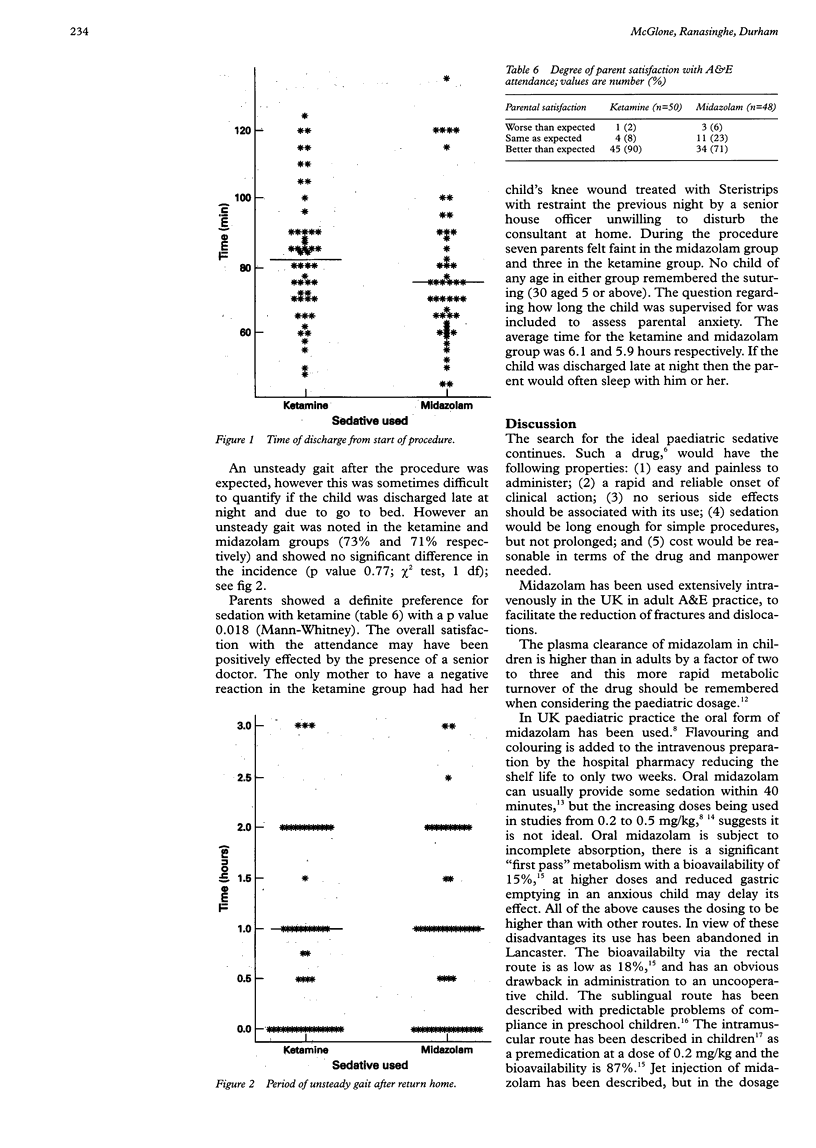
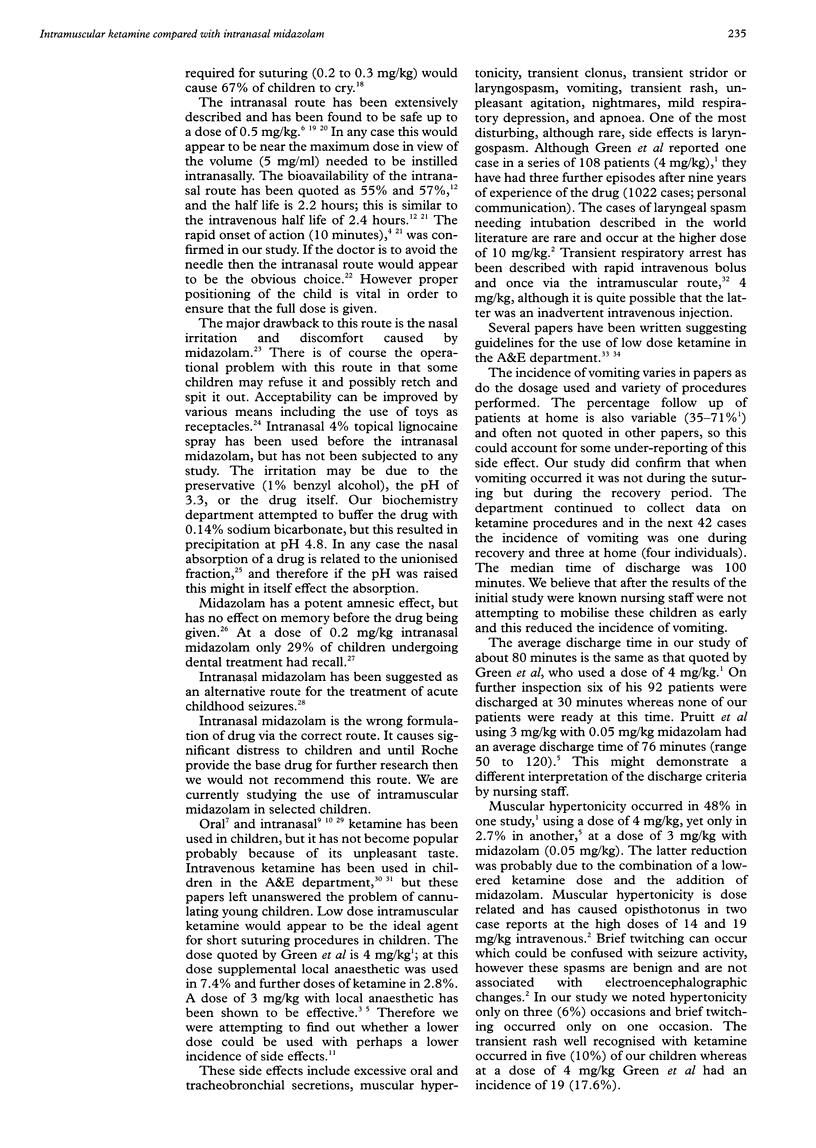
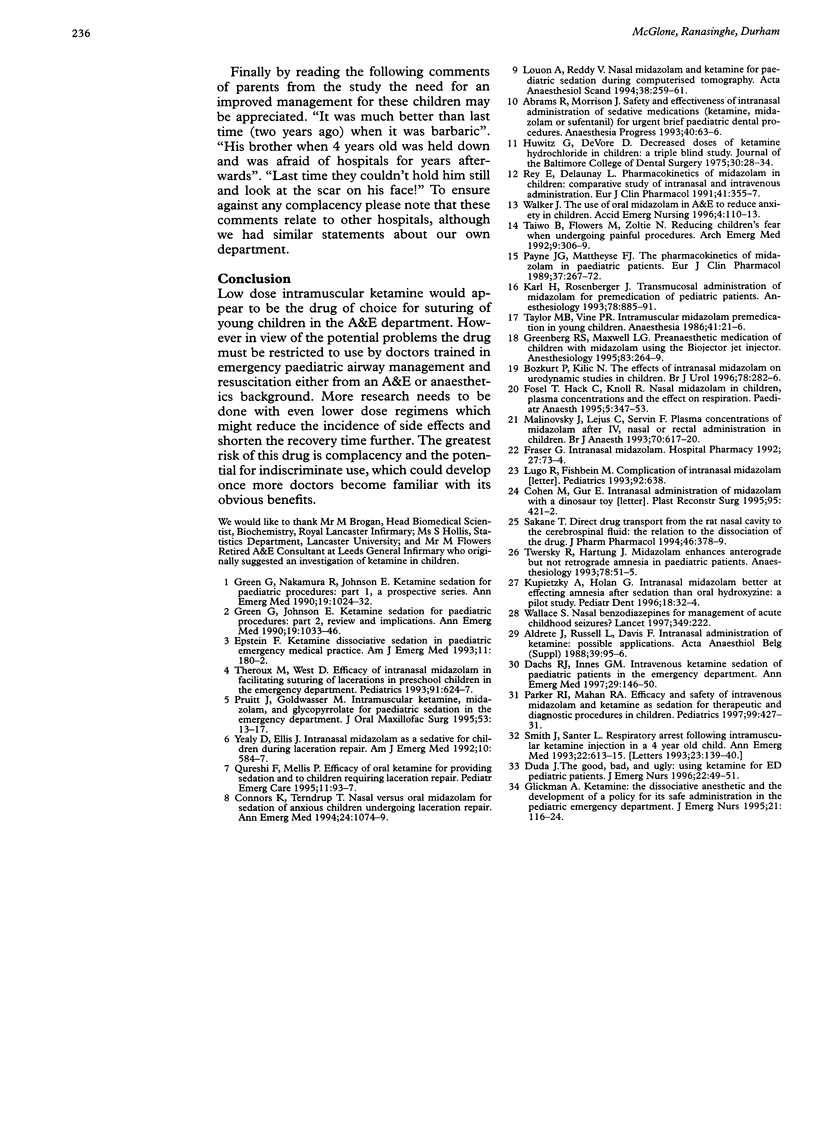
Selected References
These references are in PubMed. This may not be the complete list of references from this article.
- Aldrete J. A., Russell L. J., Davis F. A. Intranasal administration of ketamine: possible applications. Acta Anaesthesiol Belg. 1988;39(3 Suppl 2):95–96. [PubMed] [Google Scholar]
- Bozkurt P., Kilic N., Kaya G., Yeker Y., Elicevik M., Söylet Y. The effects of intranasal midazolam on urodynamic studies in children. Br J Urol. 1996 Aug;78(2):282–286. doi: 10.1046/j.1464-410x.1996.04325.x. [DOI] [PubMed] [Google Scholar]
- Cohen M., Gur E., Wertheym E., Shafir R. Intranasal administration of midazolam with a dinosaur toy. Plast Reconstr Surg. 1995 Feb;95(2):421–422. doi: 10.1097/00006534-199502000-00041. [DOI] [PubMed] [Google Scholar]
- Connors K., Terndrup T. E. Nasal versus oral midazolam for sedation of anxious children undergoing laceration repair. Ann Emerg Med. 1994 Dec;24(6):1074–1079. doi: 10.1016/s0196-0644(94)70236-5. [DOI] [PubMed] [Google Scholar]
- Dachs R. J., Innes G. M. Intravenous ketamine sedation of pediatric patients in the emergency department. Ann Emerg Med. 1997 Jan;29(1):146–150. doi: 10.1016/s0196-0644(97)70321-4. [DOI] [PubMed] [Google Scholar]
- Duda J. The good, bad, and ugly: using ketamine for ED pediatric patients. J Emerg Nurs. 1996 Feb;22(1):49–51. doi: 10.1016/s0099-1767(96)80075-4. [DOI] [PubMed] [Google Scholar]
- Epstein F. B. Ketamine dissociative sedation in pediatric emergency medical practice. Am J Emerg Med. 1993 Mar;11(2):180–182. doi: 10.1016/0735-6757(93)90115-r. [DOI] [PubMed] [Google Scholar]
- Fösel T., Hack C., Knoll R., Kraus G. B., Larsen R. Nasal midazolam in children, plasma concentrations and the effect on respiration. Paediatr Anaesth. 1995;5(6):347–353. doi: 10.1111/j.1460-9592.1995.tb00324.x. [DOI] [PubMed] [Google Scholar]
- Glickman A. Ketamine: the dissociative anesthetic and the development of a policy for its safe administration in the pediatric emergency department. J Emerg Nurs. 1995 Apr;21(2):116–124. doi: 10.1016/s0099-1767(05)80010-8. [DOI] [PubMed] [Google Scholar]
- Green S. M., Johnson N. E. Ketamine sedation for pediatric procedures: Part 2, Review and implications. Ann Emerg Med. 1990 Sep;19(9):1033–1046. doi: 10.1016/s0196-0644(05)82569-7. [DOI] [PubMed] [Google Scholar]
- Green S. M., Nakamura R., Johnson N. E. Ketamine sedation for pediatric procedures: Part 1, A prospective series. Ann Emerg Med. 1990 Sep;19(9):1024–1032. doi: 10.1016/s0196-0644(05)82568-5. [DOI] [PubMed] [Google Scholar]
- Greenberg R. S., Maxwell L. G., Zahurak M., Yaster M. Preanesthetic medication of children with midazolam using the Biojector jet injector. Anesthesiology. 1995 Aug;83(2):264–269. doi: 10.1097/00000542-199508000-00005. [DOI] [PubMed] [Google Scholar]
- Hurwitz G. A., DeVore D. T. Decreased doses of ketamine hydrochloride in children: a triple blind study. J Baltimore Coll Dent Surg. 1975 Jul;30(1):28–34. [PubMed] [Google Scholar]
- Karl H. W., Rosenberger J. L., Larach M. G., Ruffle J. M. Transmucosal administration of midazolam for premedication of pediatric patients. Comparison of the nasal and sublingual routes. Anesthesiology. 1993 May;78(5):885–891. doi: 10.1097/00000542-199305000-00013. [DOI] [PubMed] [Google Scholar]
- Kupietzky A., Holan G., Shapira J. Intranasal midazolam better at effecting amnesia after sedation than oral hydroxyzine: a pilot study. Pediatr Dent. 1996 Jan-Feb;18(1):32–34. [PubMed] [Google Scholar]
- Louon A., Reddy V. G. Nasal midazolam and ketamine for paediatric sedation during computerised tomography. Acta Anaesthesiol Scand. 1994 Apr;38(3):259–261. doi: 10.1111/j.1399-6576.1994.tb03885.x. [DOI] [PubMed] [Google Scholar]
- Lugo R. A., Fishbein M., Nahata M. C., Lininger B. Complication of intranasal midazolam. Pediatrics. 1993 Oct;92(4):638–638. [PubMed] [Google Scholar]
- Malinovsky J. M., Lejus C., Servin F., Lepage J. Y., Le Normand Y., Testa S., Cozian A., Pinaud M. Plasma concentrations of midazolam after i.v., nasal or rectal administration in children. Br J Anaesth. 1993 Jun;70(6):617–620. doi: 10.1093/bja/70.6.617. [DOI] [PubMed] [Google Scholar]
- Parker R. I., Mahan R. A., Giugliano D., Parker M. M. Efficacy and safety of intravenous midazolam and ketamine as sedation for therapeutic and diagnostic procedures in children. Pediatrics. 1997 Mar;99(3):427–431. doi: 10.1542/peds.99.3.427. [DOI] [PubMed] [Google Scholar]
- Payne K., Mattheyse F. J., Liebenberg D., Dawes T. The pharmacokinetics of midazolam in paediatric patients. Eur J Clin Pharmacol. 1989;37(3):267–272. doi: 10.1007/BF00679782. [DOI] [PubMed] [Google Scholar]
- Pruitt J. W., Goldwasser M. S., Sabol S. R., Prstojevich S. J. Intramuscular ketamine, midazolam, and glycopyrrolate for pediatric sedation in the emergency department. J Oral Maxillofac Surg. 1995 Jan;53(1):13–18. doi: 10.1016/0278-2391(95)90489-1. [DOI] [PubMed] [Google Scholar]
- Qureshi F. A., Mellis P. T., McFadden M. A. Efficacy of oral ketamine for providing sedation and analgesia to children requiring laceration repair. Pediatr Emerg Care. 1995 Apr;11(2):93–97. doi: 10.1097/00006565-199504000-00009. [DOI] [PubMed] [Google Scholar]
- Sakane T., Akizuki M., Yamashita S., Sezaki H., Nadai T. Direct drug transport from the rat nasal cavity to the cerebrospinal fluid: the relation to the dissociation of the drug. J Pharm Pharmacol. 1994 May;46(5):378–379. doi: 10.1111/j.2042-7158.1994.tb03817.x. [DOI] [PubMed] [Google Scholar]
- Smith J. A., Santer L. J. Respiratory arrest following intramuscular ketamine injection in a 4-year-old child. Ann Emerg Med. 1993 Mar;22(3):613–615. doi: 10.1016/s0196-0644(05)81956-0. [DOI] [PubMed] [Google Scholar]
- Taiwo B., Flowers M., Zoltie N. Reducing children's fear when undergoing painful procedures. Arch Emerg Med. 1992 Sep;9(3):306–309. doi: 10.1136/emj.9.3.306. [DOI] [PMC free article] [PubMed] [Google Scholar]
- Taylor M. B., Vine P. R., Hatch D. J. Intramuscular midazolam premedication in small children. A comparison with papaveretum and hyoscine. Anaesthesia. 1986 Jan;41(1):21–26. doi: 10.1111/j.1365-2044.1986.tb12698.x. [DOI] [PubMed] [Google Scholar]
- Theroux M. C., West D. W., Corddry D. H., Hyde P. M., Bachrach S. J., Cronan K. M., Kettrick R. G. Efficacy of intranasal midazolam in facilitating suturing of lacerations in preschool children in the emergency department. Pediatrics. 1993 Mar;91(3):624–627. [PubMed] [Google Scholar]
- Twersky R. S., Hartung J., Berger B. J., McClain J., Beaton C. Midazolam enhances anterograde but not retrograde amnesia in pediatric patients. Anesthesiology. 1993 Jan;78(1):51–55. doi: 10.1097/00000542-199301000-00009. [DOI] [PubMed] [Google Scholar]
- Wallace S. J. Nasal benzodiazepines for management of acute childhood seizures? Lancet. 1997 Jan 25;349(9047):222–222. doi: 10.1016/S0140-6736(05)64856-8. [DOI] [PubMed] [Google Scholar]
- Yealy D. M., Ellis J. H., Hobbs G. D., Moscati R. M. Intranasal midazolam as a sedative for children during laceration repair. Am J Emerg Med. 1992 Nov;10(6):584–587. doi: 10.1016/0735-6757(92)90190-9. [DOI] [PubMed] [Google Scholar]


